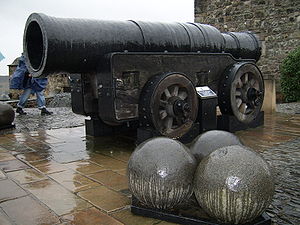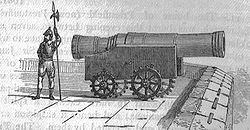- Mons Meg
-
Mons Meg
Mons Meg with its 20" (50 cm) caliber cannon ballsType Cannon Place of origin Mons, Duchy of Burgundy Service history Used by Kingdom of Scotland Production history Designer Jehan Cambier Produced June 1449 Specifications Weight 6.6 t Length 406 cm Barrel length 280 cm Shell weight 175 kg Caliber 50 cm (ball diameter) Mons Meg is a medieval supergun now located at Edinburgh Castle, Scotland. There are conflicting theories about its origins, but it appears from the accounts of Philip the Good, Duke of Burgundy that it was made to his order around 1449 and sent as a gift 8 years later to King James II of Scotland, with other artillery supplies.
Contents
History
The bombard was manufactured from longitudinal bars of iron, hooped with rings fused into one mass.[1] The Duke's artillery maker Jehan Cambier constructed it, and it was successfully tested at Mons (in the County of Hainaut in Wallonia) in June 1449; however, the Duke did not take delivery of the Mons Meg until 1453. Desiring to "interfere in English affairs"[citation needed], the Duke decided to help the Scots against the English. Mons Meg weighs 15,366 pounds (6,970 kg), is 15 feet (4.6 m) in length, and has a calibre of 20 inches (510 mm). The final cost of the gun was £1,536. 2s.
A conflicting theory, based on limited evidence, suggests it was constructed in order to aid James II in the 1452 siege of Threave Castle in the Stewartry of Kirkcudbright, when the Clan MacLellan used it to batter the castle.
The 20-inch (510 mm) calibre cannon accepted balls that weighed about 400 pounds (180 kg), although it could only be fired 8-10 times a day due to the tremendous heat generated by the powder charge required. It has been suggested that Meg was one of the armaments on James IV's carrack, the Great Michael, which would make it the ship with the largest calibre gun in history.[citation needed] In early years the gun, like the other royal cannon, was painted with red-lead to keep it from rusting. This cost 30 shillings in June 1539.[2] From the 1540s Meg was retired from active service and was fired only on ceremonial occasions from Edinburgh Castle, from where shot could be found up to two miles distant. When Mons was fired on 3 July 1558, workmen were paid to find and retrieve the shot from Wardie Mure, near the River Forth. The salute marked the solemnization of the marriage of Mary, Queen of Scots to the French Dauphin.[3]
The gun was fired in 1680 to celebrate the arrival of James Duke of Albany and York, later King James II of England and VII of Scotland, when the barrel burst. An English cannoneer had loaded the charge and many Scots believed that the damage was done on purpose out of jealousy, because the English had no cannon as big as this. The incident was also seen as a bad omen for the future King.[4]
The cannon was left outside Foog's Gate at Edinburgh Castle. It was next taken, with other disused ordnance, to the Tower of London in 1754, but was returned to the Castle in 1829, after the intervention of Sir Walter Scott. Following a restoration, it now sits outside St. Margaret's Chapel.
"Mons Meg was a large old-fashioned piece of ordnance, a great favourite with the Scottish common people; she was fabricated at Mons, in Flanders, in the reign of James IV. or V. of Scotland. This gun figures frequently in the public accounts of the time, where we find charges for grease, to grease Meg’s mouth withal (to increase, as every schoolboy knows, the loudness of the report), ribands to deck her carriage, and pipes to play before her when she was brought from the Castle to accompany the Scottish army on any distant expedition. After the Union, there was much popular apprehension that the Regalia of Scotland, and the subordinate Palladium, Mons Meg, would be carried to England to complete the odious surrender of national independence. The Regalia, sequestered from the sight of the public, were generally supposed to have been abstracted in this manner. As for Mons Meg, she remained in the Castle of Edinburgh, till, by order of the Board of Ordnance, she was actually removed to Woolwich about 1757. The Regalia, by his Majesty’s special command, have been brought forth from their place of concealment in 1818, and exposed to the view of the people, by whom they must be looked upon with deep associations; and, in this very winter of 1828–9, Mons Meg has been restored to the country, where that, which in every other place or situation was a mere mass of rusty iron, becomes once more a curious monument of antiquity" Notes to Rob Roy, Sir Walter Scott.
The gun is not called "Mons Meg" in any contemporary references until 1678. In 1489, she first appears in record as "Monss,"[5] and in the painter's account of 1539 she is called; "Monce in the castell," the only piece with an individual name. In 1650 she was noted as "Muckle Meg."[6] "Meg" may either be a reference to Margaret of Denmark, Queen of James III of Scotland, or simply an alliteration, while Mons was one of the locations where the cannon was originally tested. McKenzie records that this class of artillery was known as a murderer and Mons Meg was certainly described as such.[7]
Besides the Mons Meg, a number of 15th-century European superguns are known to have been employed primarily in siege warfare, including the wrought-iron pieces Pumhart von Steyr and Dulle Griet as well as the cast-bronze Faule Mette, Faule Grete and Grose Bochse.
During the Hogmanay celebrations of 2009/2010 the District Gunner, Sgt Jamie Shannon (also known as "Shannon the Cannon") fired Mons Meg from Edinburgh Castle.[8] A cannonball was placed inside the weapon for visual effect, while the powder was ignited by use of a car battery.
Evolution of the carriage
For a while in its early days the Mons sat on a plain box without any wheels. Evidently, when Mons Meg was removed from Edinburgh Castle in 1754, her carriage had long since rotted away. A contemporary account describes her as lying "on the ground" near the innermost gate to the castle.[9] Presumably the Ordnance Board fabricated a new carriage after her arrival at the Tower.
In 1835, after the return of Mons Meg to Edinburgh Castle, the London-made carriage rotted away too and fabrication of a cast-iron replacement was undertaken.
As we see Mons Meg today, it is mounted on a reproduction of the carriage depicted in a stone carving of ca. 1500 on a wall of Edinburgh Castle.
Notes
- ^ Chambers, Robert (1885). Domestic Annals of Scotland. Edinburgh : W & R Chambers. p. 330
- ^ Accounts of the Lord High Treasurer of Scotland, vol. 7 (1907), 222.
- ^ Accounts of the Lord High Treasurer of Scotland, vol. 1 (1877), ccxxiii footnote; vol. 10, (1913), lxxv-lxxvi, 367.
- ^ Chambers, Robert (1885). Domestic Annals of Scotland. Edinburgh : W & R Chambers. p. 329.
- ^ Accounts of the Lord High Treasurer of Scotland, vol. 1, Edinburgh (1877), ccxx-ccxxiii, 115.
- ^ Accounts of the Lord High Treasurer of Scotland, vol. 7 (1907), 222.
- ^ McKenzie, Page 319
- ^ Mod national archives retrieved 17.00, 14/05/10 http://webarchive.nationalarchives.gov.uk/tna/+/http://www.mod.uk:80/DefenceInternet/DefenceNews/PeopleInDefence/shannonTheCannonEdinburghsDistrictGunner.htm
- ^ Blair, Claude (1967). A New Carriage for Mons Meg.Journal of the Arms and Armour Society London V(12) pages 431 - 452.
See also
- List of the largest cannon by caliber
References
- Gaier, Claude (1967) The Origin of Mons Meg. Journal of the Arms and Armour Society London V(12) 425-431
- Grose, Francis (1801) Military Antiquities respecting a History of the English Army from the Conquest to the Present Time. T. Egerton and G. Kearsley London, UK
- Hewitt, J (1853) Mons Meg the ancient bombard, preserved at Edinburgh castle. Archeological Journal 10 25-32
- Lead, Peter (1984) Mons Meg: A Royal Cannon. Mennock Publishing Cheshire, UK
- McKenzie, Agnes Mure (1948). Scottish Pageant 1513-1625. Edinburgh : Oliver & Boyd.
- Norris, John (2003) Early Gunpowder Artillery 1300-1600 Motorbooks International
- Paul, Sir James Balfour (1915–1916) Ancient Artillery. With Some Notes on Mons Meg. Proceedings of the Society of Antiquaries of Scotland 50 191-201
- Sands, Kathleen (1999) Though one of the best-documented of medieval bombards, Mons Meg was the subject of exaggeration and legend Military History. 16(3) 22-23
- Scott, Sir Walter (1817) Waverley Novels, Rob Roy (Notes G) Edinburgh
- Schmidtchen, Volker (1977), "Riesengeschütze des 15. Jahrhunderts. Technische Höchstleistungen ihrer Zeit", Technikgeschichte 44 (2): 153–173 (166–168)
- Smith, Robert D and Brown, Ruth Rhynas Bombards- Mons Meg and her sisters Royal Armouries Monograph 1 ISBN 0948092092
External links
 Media related to Mons Meg at Wikimedia Commons
Media related to Mons Meg at Wikimedia Commons- The official Edinburgh Castle website
- Mons Meg at Edinburgh Castle
- Photo of Mons Meg from RampantScotland.com
Weapon types Arquebus · Bâton à feu · Bombard · Crapaudin · Culverin · Fauconneau · Pot-de-fer · Perrier à boîte · Ribauldequin · VeuglaireFamous guns By country FranceRelated Categories:- Superguns
- 560 mm artillery
- Artillery of Belgium
- Artillery of the United Kingdom
- Medieval artillery
- Visitor attractions in Edinburgh
- History of Edinburgh
- Edinburgh Castle
- Military history of Scotland
Wikimedia Foundation. 2010.




